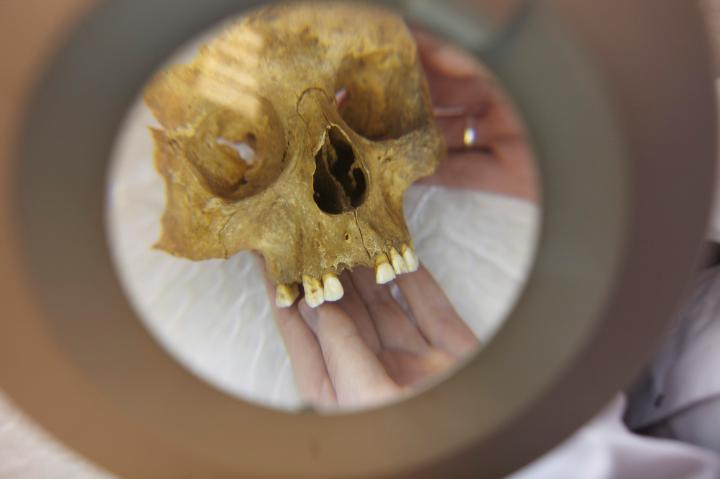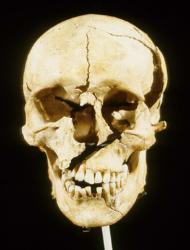Biological Anthropology Research Centre (BARC) projects
From Cemetery to Clinic
A project supported by Jisc to digitise aspects of the Chichester Leprosarium cemetery and clinical images of leprosy (Hansen's disease). The 'From Cemetery to Clinic' website brings together the archaeological archive, skeletal data, 3D laser scans of leprous bones, pathological and clinical descriptions alongside a unique collection of clinical radiographs of individuals with leprosy. The project was a collaboration between Archaeological and Forensic Sciences and the Centre for Visual Computing, University of Bradford.
Digitised Diseases
'Digitised Diseases: informing clinical understanding of chronic conditions affecting the skeleton using archaeological and historical exemplars', this is the follow on project to the pilot 'From Cemetery to Clinic', please visit the 'Digitised Diseases' website.
The Bradford Tooth Fairy Project
Human dentine - a unique biomarker for in utero experience and nutritional stress in the womb and a predictor of health in later life?
Academic Lead: Dr Julia Beaumont
The quality of the in utero environment can affect the long-term health of an adult. From modern studies of nutritional stress we know physiological changes, as well as dietary information, are recorded in incrementally-growing tissues such as hair and fingernails through changes in the nitrogen (δ15N) and carbon isotope ratios (δ13C). Raised δ15N related to the period of starvation was identified in my study of teeth from Irish Famine victims.
The only extant tissue in the human body formed in utero is primary dentine within deciduous teeth. I have developed a novel method of analysing tiny archaeological dentine samples showing that in utero nitrogen isotope ratios are higher and wider in range than predicted: thus if high nitrogen values reflect maternal/infant stress during pregnancy this could then be used to reconstruct the diet and health of the mother, and thus the developing infant. A small pilot study of modern teeth with perinatal medical histories suggests this is the case.
Being awarded the Rank Prize New Lecturer award allows me to collect 250 exfoliated or extracted deciduous teeth together with medical histories in collaboration with Ethical Tissue and to analyse them at the Bradford isotope laboratory in order to provide proof-of-concept for a much larger study of diet and physiology during childhood. It would then be possible to use measurement of dentine as a technique to identify children at risk of disease in later life, as a forensic tool in cases of neglect, and also to study the maternal/infant health in ancient populations.
Stirling Castle
Dr Jo Buckberry is co-ordinating an investigation of a small group of skeletons excavated at Stirling Castle in 1997-1998. They were buried in a small building believed to be an early Chapel, and have been radiocarbon dated to the 13th to 16th centuries.
To date the skeletal analysis has identified a wide range of trauma, including healed bone fractures, healed sharp force trauma, and a large number of peri-mortem fractures to some of the skeletons. Most of the trauma identified is blunt-force, which makes it more difficult to interpret, but a small number of sharp-force and penetrating injuries suggest that some individuals died in violent conflict. Most of the skeletons date to the period of the Scottish Wars of Independence, and it is possible that they were involved in one of the many conflicts that occurred around Stirling during this time. A high prevalence of developmental anomalies suggests these individuals may have come from a small gene pool, possibly the higher status families of medieval Britain. Initial findings from the skeletal analysis have been published in Ewart and Gallagher (2015).

The current project is further investigating the biological identity of the skeletons, evidence of pathology and trauma. The project includes a DNA analysis with Dr Turi King (University of Leicester), isotopic investigations of diet and migration, undertaken in collaboration with Dr Julia Beaumont (University of Bradford), Dr Janet Montgomery (Durham University) and Professor Julia Lee-Thorp (University of Oxford) and biomarkers of scurvy with Dr Hannah Koon (University of Bradford). Dr Cathy Batt (University of Bradford) is leading on the Bayesian modelling of the radiocarbon dates. Evidence of trauma is being compared with identified forensic cases, and investigated radiographically and microscopically, to further understand the trauma and breadth of the peri-mortem window.
Funding and Dissemination
This project is funded by Historic Environment Scotland. Preliminary results have featured on ‘History Cold Case’ (BBC 2), ‘Braveheart: The True Story’ (Channel 5) and ‘Unearthed’ (Science Channel). We have presented the results at a variety of national and international conferences and at public events at Stirling Castle (Road to Bannockburn, Great Big History Weekend) and Fort George (Amazing Ages).
Ewart, G. and Gallagher, D. 2015. With Thy Towers High. The Archaeology of Stirling Castle and Palace. Archaeology Report no 9. Historic Scotland.
Putting Flesh on the Bones: cataloguing and digitising the Calvin Wells Archive
Funded by the Wellcome Trust, this project will unlock a hidden collection with huge potential for research, teaching and public engagement. It's all about the bones!
Towton mass grave project
What transpired at Towton on a snowy Palm Sunday, March 29th, 1461, has ever since been something of a mystery, despite the battle being one of the largest and bloodiest ever fought on English soil.
Historically, the battle marked a turning point in the Wars of the Roses that confirmed the Yorkist Edward IV's accession to the throne of England. During the battle and ensuing rout of the Lancastrians, an estimated 28,000 men lost their lives. The application of forensic anthropological techniques for identifying and recording injuries has allowed us to confirm that the individuals from the pit were casualties of an extremely violent encounter. Moreover, they provide a unique glimpse of the personal consequences of battle for some who took part.

You Are What You Ate
You Are What You Ate is an innovative new project run by historians, scientists, historical re-enactors and archaeologists. We want to bring up-to-date research on food science, nutrition, medical history and archaeology to a wider audience.
Our aim is to encourage public debate and personal reflection on modern eating habits through exploration of the dietary choices of the past.
